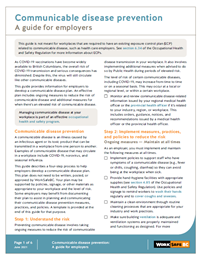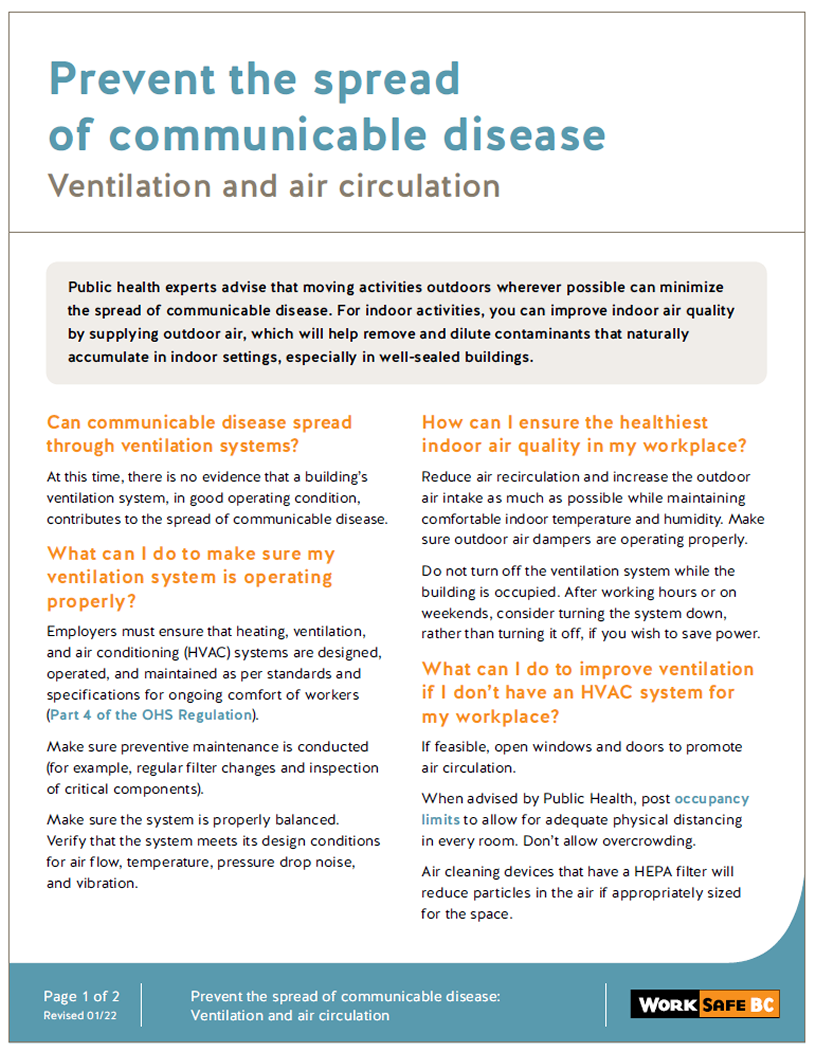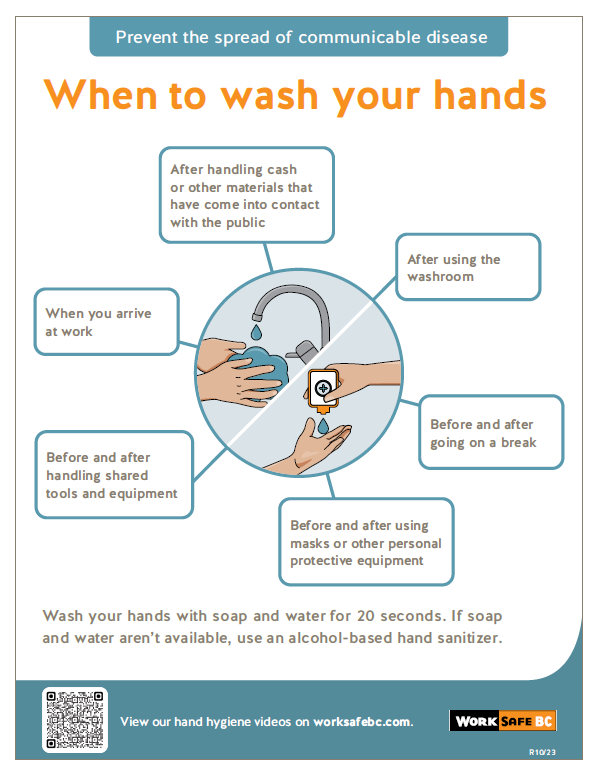Communicable disease prevention
The following information will help you to understand communicable disease, how to prevent it in your workplace, and how to respond to periods of elevated risk.
Provincial government ends public health emergency for COVID-19
Effective July 26, 2024, B.C.’s provincial health officer (PHO) has issued an order to end the public health emergency for COVID-19 and has rescinded all related orders.
View the public health order: Passing of the COVID-19 Public Health Emergency and Rescinding of Provincial Health Officer Orders.
Immune status reporting for health care workers in B.C.
As all related health care orders have been rescinded, there is no longer a COVID-19 vaccine mandate for health-authority-operated and contracted facilities. However, moving forward, health care workers will be required to report their immunization for COVID-19 and influenza, and their immune status for other “critical vaccine preventable diseases.”
For more information, visit Immune status reporting for health care workers in B.C.
Fundamentals of communicable disease prevention
Employers and workers can learn more about the workplace requirements to implement communicable disease prevention in OHS Guideline G-P2-21 Communicable disease prevention.
- A communicable disease is an illness caused by an infectious agent or its toxic product that can be transmitted in a workplace from person to person. Examples of communicable diseases that may circulate in a workplace include COVID-19, norovirus, and seasonal influenza.
- Communicable disease prevention focuses on basic risk reduction principles to reduce the risk of workplace transmission of COVID-19 and other communicable diseases. The fundamental components of communicable disease prevention include both ongoing measures to maintain at all times and additional measures to be implemented as advised by public health.
- Ongoing measures — Maintain at all times:
- Implement policies to support workers who have symptoms of a communicable disease (for example, fever and/or chills, recent onset of coughing, diarrhea), so they can avoid being at the workplace when sick
- Promote hand hygiene by providing hand hygiene facilities with appropriate supplies and reminding employees through policies and signage to wash their hands regularly and to use appropriate hygiene practices.
- Maintain a clean environment through routine cleaning processes.
- Ensure building ventilation is properly maintained and functioning as designed.
- Support employees in receiving vaccinations for vaccine-preventable conditions to the extent that you are able.
- Additional measures — Implement as advised by public health:
- Employers must also be prepared to implement additional prevention measures as required by a medical health officer or the provincial health officer to deal with communicable diseases in their workplace or region, should those be necessary.
- Ongoing measures — Maintain at all times:
- Communicable disease prevention involves understanding the level of risk in your workplace, application of the fundamentals and implementing appropriate measures to reduce the risk, communicating policies and protocols to all workers, and updating measures and safeguards as required.
- Employers do not have to write or post plans for communicable disease prevention or have them approved by WorkSafeBC. Some employers may benefit from documenting their plan to assist in planning and communicating their communicable disease prevention measures, practices, and policies. A template is provided at the end of Communicable disease prevention: A guide for employers for that purpose.
- Managing communicable disease at your workplace is part of an effective Occupational Health and Safety Program.
Communicable disease prevention: A guide for employers
WorkSafeBC has developed this resource to assist employers in the fundamental components of communicable disease prevention. This guide describes a four-step process to help employers reduce the risk of communicable disease in their workplace. This involves understanding the level of risk in the workplace, application of the fundamentals and implementing appropriate measures to reduce the risk, communicating policies and protocols to all workers, and updating measures and safeguards as required. The guide includes a template that may be useful for employers to document and communicate their communicable disease prevention measures, practices, and policies.
Responding to elevated risk
Although the COVID-19 virus is now managed primarily through vaccination, like all communicable diseases, it may still circulate. Similarly, the level of risk of certain communicable diseases, including COVID-19, may elevate from time to time or on a seasonal basis. This may occur at a local or regional level or within a workplace. In these cases, employers will be advised by medical health officers or the provincial health officer of the measures they need to take to manage the risk.
Employers are required to monitor for communicable disease-related information from their regional public health officials and the provincial health officer related to their area and industry, and to follow that guidance and direction should additional measures be necessary in their workplace.
Frequently asked questions
Do I need to develop a written communicable disease plan, and does this need to be posted at my workplace like the COVID-19 Safety Plan was?
Employers are expected to take reasonable steps to manage health and safety in their workplace, including preventing communicable disease transmission. Other than in specific instances where exposure control plans are required to control the transmission of communicable disease, such as health care, your plan does not need to be written, posted, or approved by WorkSafeBC. Employers may refer to Communicable disease prevention: A guide for employers for steps they can take to effectively manage communicable disease.
What can I expect from a WorkSafeBC inspection for communicable disease prevention?
During an inspection, employers may be asked to demonstrate that they have practices in place to prevent communicable disease transmission in their workplace, and that they are following any orders, guidance, or recommendations from their regional health authority or the provincial health officer that applies to their workplace.
Are there industry specific protocols available for communicable disease prevention?
Communicable disease prevention is based on basic principles for maintaining worker health and reducing the risks to workers in all workplaces from communicable disease. More information is provided in Communicable disease prevention: A guide for employers.
Do I need to keep some of the existing protocols from my COVID-19 Safety Plan?
Some of the fundamental elements of communicable disease prevention are similar to the measures employers and workers followed during the pandemic, including:
- Not coming to work if you are sick
- Healthy hand hygiene practices, including hand washing and covering coughs and sneezes
- Maintaining a clean work environment
- Ensuring adequate ventilation
- Supporting employees in receiving vaccinations for vaccine-preventable conditions to the extent that you are able
There may also be instances where, based on direction from public health, employers may need to re-introduce additional safety measures if there’s an elevated risk of COVID-19 transmission or other communicable diseases in their workplace or community.
How will I know if there is an elevated risk of a communicable disease in my workplace or community?
Employers are required to monitor and review communicable disease-related information issued by their regional medical health officer or the provincial health officer related to their industry, region, or workplace.
What do I do if there is a situation of elevated communicable disease in my workplace or community?
During a period of elevated risk, the medical health officer or provincial health officer will provide information and guidance about the risk and how employers can reduce it. The measures that employers will need to implement will depend on the type of disease and the methods of transmission.
Can I require a worker to be vaccinated as a condition of employment?
One of the ongoing communicable disease prevention measures to maintain is supporting employees in receiving vaccinations for vaccine-preventable conditions to the extent that you are able.
As every workplace is different, employers should seek advice when considering a mandatory vaccination policy, as they will need to balance workplace health and safety with privacy, labour, and employment issues.
What resources exist to help employers understand what to consider for their vaccination policies?
As well as seeking legal advice, employers can also refer to the following resources to learn more about what to consider about developing a mandatory vaccination policy:
- Industry and business associations: Employers may wish to look to their industry and business associations for resources and links specific to their workplace. For example, the Business Council of British Columbia has published advice on this topic in its report, Mandatory vaccines in the workplace.
- Employers’ Advisers Office: Employers can also reach out to the Employers’ Advisers Office at 1.800.925.2233 for additional assistance and guidance with respect to COVID-19 questions, including workplace vaccination issues.
- A human rights approach to proof of vaccination during the COVID-19 pandemic: Published by B.C.’s Office of the Human Rights Commissioner, this document provides advice and guidance on some of the principles employers should take into account when determining whether vaccination status policies can be justified under B.C.’s Human Rights Code in their specific circumstances.
Can a worker refuse unsafe work because a co-worker has not been vaccinated for a communicable disease?
For information on the right to refuse unsafe work and what workers can do to stay safe at work, see Refusing unsafe work.
If you have a question or concern
Workers and employers with questions or concerns about workplace exposure to communicable diseases can call WorkSafeBC’s Prevention Information Line at 604.276.3100 in the Lower Mainland (toll-free within B.C. at 1.888.621.SAFE). You’ll be able to speak to a prevention officer to get answers to your questions, and if required, a prevention officer will be assigned to assess the health and safety risk at your workplace.
Related links
- Orders, notices, or guidance issued by the provincial health officer
- OHS Guideline G-P2-21 Communicable disease prevention



